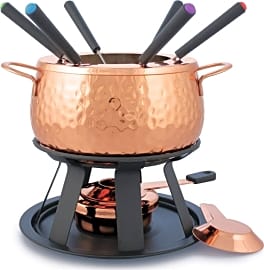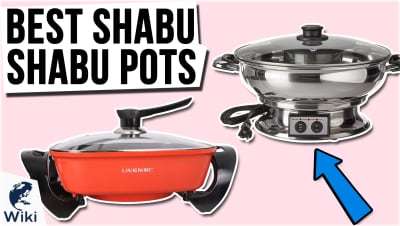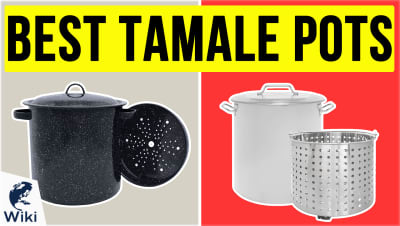The 10 Best Fondue Pots

This wiki has been updated 40 times since it was first published in June of 2015. A fondue set can enable you to prepare and serve a variety of foods, from delicious broths for cooking meats and veggies to thick, creamy cheeses for coating bread, and, of course, melted chocolate to dip fruit in. Owning your own maker will give you an easy-to-use centerpiece for dinner parties and let you liven up family meals, whether you opt for one that runs on electricity or uses a burner. When users buy our independently chosen editorial choices, we may earn commissions to help fund the Wiki.
Editor's Notes
August 26, 2020:
Because they blend usefulness with style quite well, we still believe that the Swissmar Lugano and the Artestia Electric make strong choices for a variety of users. The Swissmar Gruyere 9-Piece, too, deserves a mention; thanks to its handsome design, you can transport your guests to the Alps, but without ever leaving your home. Like the aforementioned, it's just as functional as it is attractive, with a 2.8-quart capacity and microwave-safe ceramic pot.
As for new additions, we selected the diminutive Boska Holland Tapas and The Rock by Starfrit. We appreciate the latter's magnetic breakaway cord that helps mitigate disaster should the entire unit be knocked over by an overzealous party guest. But speaking of safety, remember that any model should be treated cautiously to avoid burns caused by spills. It's generally considered wise not to let very young kids get in on the fun, especially if you'll be indulging in fondue bourguignon, since this method of cooking meat requires hot oil. If you want to try this meat dish, consider the Swissmar Biel and be sure to invest in a quality deep fry/candy thermometer.
May 03, 2019:
Other than durability and aesthetics, the capacity of a fondue pot, its construction materials, and heating method (via a burner or an electric coil) are some of the most important aspects to consider before you buy one. We included models that combine a variety of the aforementioned features in order to suit every possible need.
While the Trudeau Alto 3-In-1 boasts a sleek look and thoughtful design, recurring reports of inconsistent operation led us to remove it in favor of the Swissmar Biel, which not only equals it in attractiveness but is also superior for meat fondue.
We let go of the VonShef 500ml due to availability issues but continued with the brand by adding the VonShef Stylish, which is still compact and easy to use. It's also close in looks to the rustic Swissmar Sierra 11-Piece, which we swapped out due to a design error that had users frustrated.
The Cuisinart CFO-3SS represents a great value for money, as does the Nostalgia FPS200 6-Cup, and we kept the remaining Swissmar brands and our #2 Artestia AR-89010 at the top three spots because all are very well made, attractive, simple to use, and boast generous capacities that can serve multiple people.
Special Honors
Mauviel Copper The Mauviel Copper is just as much statement piece as it is cookware, thanks to its eye-catching copper construction that conducts heat well. The non-reactive tin liner ensures that it's completely food safe and easy to clean, although you may need to polish the exterior from time to time. williams-sonoma.com
Melts In Your Pot
Both cheeses and chocolates melt into that ideal fondue texture when heat lets their respective fat molecules drift and spread.
When most people think of fondue, the initial image conjured to the mind is one of a strawberry emerging from a pot of molten chocolate, a long strand of melted cocoa stretching between two worlds.
If you're more of a cheese lover, you might, instead, see a perfectly cubed piece of bread oozing with a cream-colored cheese.
Either way, the two most common ideas of fondue rely on the phenomenon of the melt. But what makes cheese or chocolate melt into that brilliant goo? Heat is the obvious answer, but it's not the whole picture.
Fondue pots create heat in one of two ways. Either they produce it from an internal coil that's excited by electricity, as with your plug and play fondue pots, or they sit above a small flame.
Both methods heat pretty slowly (though electric is faster), so most fondue is made on the stovetop and transferred to the fondue pot where it's kept at just the right temperature for serving.
That's all well and good, but it doesn't quite get to the heart of my question. After all, if I put ice in a fondue pot, I certainly can't enjoy the same dipping experience in the water that the ice becomes as I can the thick, sweet chocolate lava.
What it comes down to, then, is fat. Both cheeses and chocolates melt into that ideal fondue texture when heat lets their respective fat molecules drift and spread.
If a cheese has too low a moisture content, like a Parmesan, the fat has less wiggle room, and the cheese won't melt as much. Similarly, if acid has been employed in its processing, as is the case with ricotta, for example, the bound proteins prevent those fats from melting properly.
Chocolates can suffer the same fate if improperly made, but usually the concern there is with corners cut in the quality of ingredients. The fat in chocolate that makes it so perfect is its cacao butter, which, for the record, is not a dairy ingredient. It's butter in much the same way that peanut butter is butter.
Oftentimes, chocolate manufacturers will use little to no cacao butter to save as much money as possible, and they replace the missing fat content with soy lecithin or hydrogenated vegetable oils.
The result is a chocolate that will still melt, but the flavor and texture are nowhere near the quality of pure, 100% cacao butter chocolate.
Lots Of Pots
There are as many brands and styles of fondue pots out there as there are variations of cheese fondue recipes, and one good thing about these devices is that they're all built to last a good long while.
The only downside to that durability is that you won't have a good reason to upgrade should you decide you want a bigger, better pot.
To help make your decision as simple as possible, we'll look a little more deeply into the two main styles of pots, and let you choose from among your preferred camp.
That said, flame based fondue pots are inevitably going to last longer than electrics since they have next to nothing that can go wrong.
Electric fondue pots can get a lot bigger since the only thing they need to compensate for any increased surface area is a larger heating coil.
Flame-based fondue pots are limited by the available sizes of fire canisters, and the limits presented by the width of a single flame. Pass a certain diameter on the bottom of the pot and your heat won't be evenly distributed.
That said, flame based fondue pots are inevitably going to last longer than electrics since they have next to nothing that can go wrong. A connection in your electric unit might short out, and then you have no heat.
The other consideration is stylistic. Electric units look flashier in more modern kitchens, and the more traditional pots will fit in better in a homier space.
Know how many people you want to feed, and know what kind of impression you want to make. The rest of your decision will be primarily feature-based.
Fondue's Not So Rustic Origins
The history of the fondue pot itself is inseparable from the history of fondue, the oldest known recipe for which dates back to Switzerland at the turn of the 18th century.
Given the proximity of the countries, it's difficult to say for sure whether the dish originated in Switzerland, France, or Italy, but the Swiss do claim it as a national dish.
No, the cheeses called for in the earliest fondue recipes were expensive imports, and there wasn't much likelihood that the peasants were splurging on Gruyere.
The myth that still surrounds it, though, is that it was a kind of peasant food served up in the mountains. Nothing could be farther from the truth. Fondue from then and now share something very important in common, and that's fancy cheeses. I don't mean old farmer's cheeses that almost disappeared only to have some brilliant capitalist rebrand them as artisanal.
No, the cheeses called for in the earliest fondue recipes were expensive imports, and there wasn't much likelihood that the peasants were splurging on Gruyere.
It wasn't until the 1960s that a fondue craze took root in the US. Take yourself to any garage sale in any suburb in middle America, and you're bound to find somebody's grandmother's dust-encrusted, 60-year-old fondue set.
Since then, not much has changed in the design of the pots, though electric units eventually came along to threaten the traditional models, and the fire gels have gotten a little safer and hotter.















